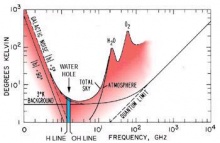“SETI 的历史 - 3”的版本间差异
跳转到导航
跳转到搜索
小 (更新死链) |
|||
| (未显示2个用户的20个中间版本) | |||
| 第1行: | 第1行: | ||
| − | <资料来源:[http://www.planetary.org/explore/topics/seti/seti_history_03.html | + | <资料来源:[https://archive.md/2008.11.15-120813/http://www.planetary.org/explore/topics/seti/seti_history_03.html A Blueprint for SETI]> |
| − | ==''' | + | =='''第3章:SETI 的蓝图'''== |
| − | Morrison | + | Morrison 和 Cocconi 的短文成为了过去 40 年来大多数 [[SETI]] 项目的蓝图。电磁信号作为最有希望的星际通讯手段的猜想成为了所有搜索项目的基本假设,也包括[[光学 SETI]] 项目。来自外星文明的信号将发生多普勒漂移的假设也被采纳到后来所有的 SETI 项目中,这些项目都无一例外的检查信号的频率漂移。但文中最重要的建议是外星文明最有可能使用的“通用”传输频率。1420MHz 到今日仍然是 SETI 项目中最流行的搜寻频率。 |
| − | |||
| + | [[Image:Water_hole.jpg|220px|right|thumb|'''水坑''' - 这个神奇的频率介于 1420MHz 和 1660MHz 之间,许多 SETI 科学家相信这是最有希望的 SETI 搜寻频带。]] | ||
| − | + | 在随后的几年中,另外一位 SETI 先驱 - 惠普公司副总裁 Bernard Oliver - 提出了另外一个神奇的频率:1662MHz,该发射频率来自一种非常常见的分子 -OH,即氢氧根。氢与氢氧根结合成 H<sub>2</sub>O - 水 - 这是我们所知的生命类型中最基本的构成。和 1420MHz 相似,1662MHz 也处于频谱中相关“宁静”的区域。Oliver 相信在这个频带范围发现外星文明信号会是最有希望的:“对于水基生物,寻觅它的同类在位于水的分离物共振态之间的频带肯定是最理想的。而我们将在哪里相遇,毫无疑问在水坑!”Oliver 写于 1971 年。自那时起,“水坑”这个术语就被用来表示位于或在氢线附近频率的搜索方法。 | |
| − | |||
| − | |||
| + | Morrison 和 Cocconi 的文章是一个呼吁行动,他们希望检验这些理论。Cocconi 联系了当时世界上单碟最大的 Jodrell Bank 射电天文台的 Bernard Lovell 先生,希望能让望远镜拨出时间对外星文明的信号进行搜寻。然而 Bernard 先生对此持怀疑态度,并未能提供合作。启动第一次外星文明信号的搜寻只好留给他人。 | ||
| − | |||
| − | [[ | + | [[SETI 的历史|'''返回 SETI 的历史 ←''']] | [[SETI 的历史 - 2|'''第2章:SETI 成立的瞬间 ←''']] | [[SETI 的历史 - 4|'''→ 第4章:Ozma 项目的起源''']] |
| − | |||
| − | |||
| − | |||
| − | |||
| − | |||
| − | |||
| − | |||
2019年2月12日 (二) 20:26的最新版本
<资料来源:A Blueprint for SETI>
第3章:SETI 的蓝图
Morrison 和 Cocconi 的短文成为了过去 40 年来大多数 SETI 项目的蓝图。电磁信号作为最有希望的星际通讯手段的猜想成为了所有搜索项目的基本假设,也包括光学 SETI 项目。来自外星文明的信号将发生多普勒漂移的假设也被采纳到后来所有的 SETI 项目中,这些项目都无一例外的检查信号的频率漂移。但文中最重要的建议是外星文明最有可能使用的“通用”传输频率。1420MHz 到今日仍然是 SETI 项目中最流行的搜寻频率。
在随后的几年中,另外一位 SETI 先驱 - 惠普公司副总裁 Bernard Oliver - 提出了另外一个神奇的频率:1662MHz,该发射频率来自一种非常常见的分子 -OH,即氢氧根。氢与氢氧根结合成 H2O - 水 - 这是我们所知的生命类型中最基本的构成。和 1420MHz 相似,1662MHz 也处于频谱中相关“宁静”的区域。Oliver 相信在这个频带范围发现外星文明信号会是最有希望的:“对于水基生物,寻觅它的同类在位于水的分离物共振态之间的频带肯定是最理想的。而我们将在哪里相遇,毫无疑问在水坑!”Oliver 写于 1971 年。自那时起,“水坑”这个术语就被用来表示位于或在氢线附近频率的搜索方法。
Morrison 和 Cocconi 的文章是一个呼吁行动,他们希望检验这些理论。Cocconi 联系了当时世界上单碟最大的 Jodrell Bank 射电天文台的 Bernard Lovell 先生,希望能让望远镜拨出时间对外星文明的信号进行搜寻。然而 Bernard 先生对此持怀疑态度,并未能提供合作。启动第一次外星文明信号的搜寻只好留给他人。
